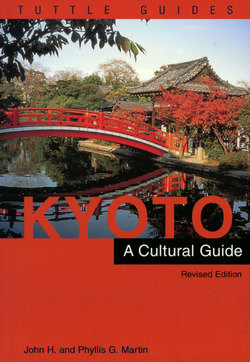Kyoto a Cultural Guide

Реклама. ООО «ЛитРес», ИНН: 7719571260.
Оглавление
John H. Martin. Kyoto a Cultural Guide
Отрывок из книги
Kyoto and Its Heritage
TO EXPERIENCE the essence of Kyoto, one should walk its avenues and its streets, its alleys and its byways. Only in this manner can one appreciate the spirit of the place—its quiet lanes, its bustling main thoroughfares, and its juxtaposition of houses and shops, temples and shrines, gardens and industries.
.....
Nishi-muki Jizo On leaving the Hondo and walking toward the hillside, one should bypass the grand stairway leading down to the Otowa Falls in order that the four small buildings that close the temple grounds on the east can be visited. The first of these houses the minor Nishi-muki Jizo (Westward-Facing Jizo) dedicated to the bodhisattva who protects children, travelers, and the dead. To the right of the Jizo Shrine is the thatch-roofed Shakado (Buddha's Hall). Within is a three-foot-tall smiling image of the Shaka Buddha seated on a golden lotus flower. A nimbus appears behind his head, and a magnificent lacelike aureole behind the full image is enriched with flying angels (apsaras) carrying musical instruments. On either side of the Shaka stands a thirteen-inch-tall Fugen and a Monju, the Buddhist deities of virtue and wisdom. Between the Shaka-do and its neighboring Amida-do (Amida Hall) are some 180 small Jizo images sitting under an open, roofed structure known as the Hall of One Hundred Jizo (Hyakutaijizo). One folk tale holds that bereaved parents can view these images and, if they find one that resembles their dead child, can rest assured that the child is at peace.
Amida-do the Amida-do to the south of the Shaka-do has the traditional tiled roof of Buddhist temples. The building is divided into three sections: the first portion holds many ihai, memorial tablets to the dead; the middle section holds the Amida Nyorai image which is 6.25 feet tall, its hands arranged in the mudra (the symbolic position of the hands) indicating contemplation. Amida is the Buddha of the Western Paradise, and the golden aureole behind his image has the traditional one thousand Buddha figures in relief as well as a number of larger such images also in raised relief. It was here that the doctrine of the nenbutsu (Namu Amida Butsu —Praise to the Buddha Amida) was proclaimed in 1188 by Priest Honen, thereby creating the cult of Amida and the Jodo sect of Buddhism. The repetition of this phrase insures one of being received by Amida into his western paradise after death. A special nenbutsu service takes place here five times a year.
.....